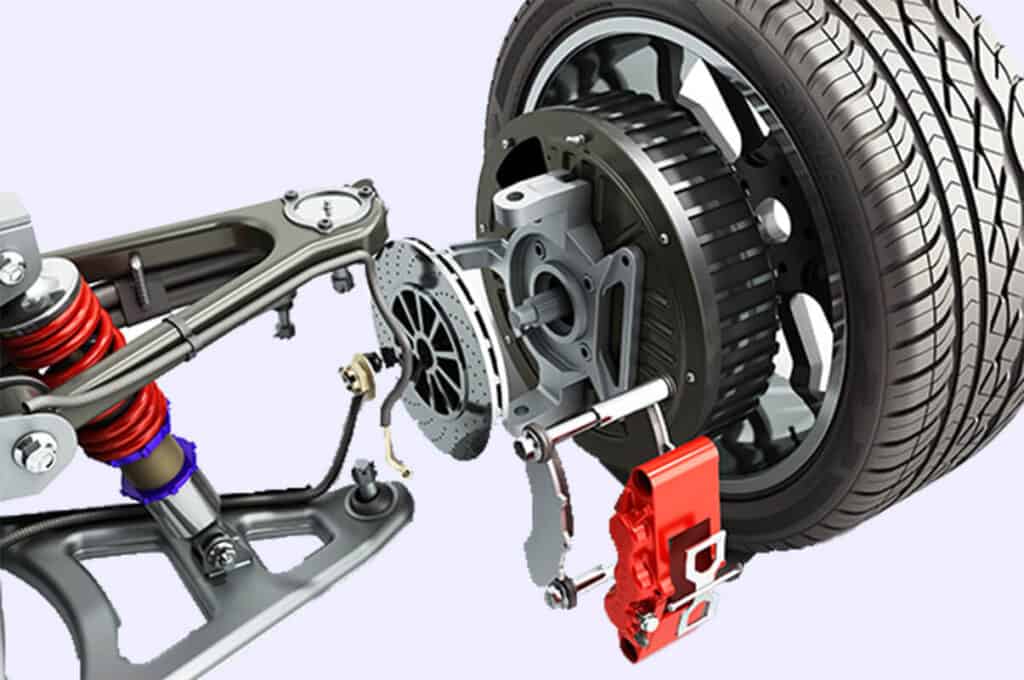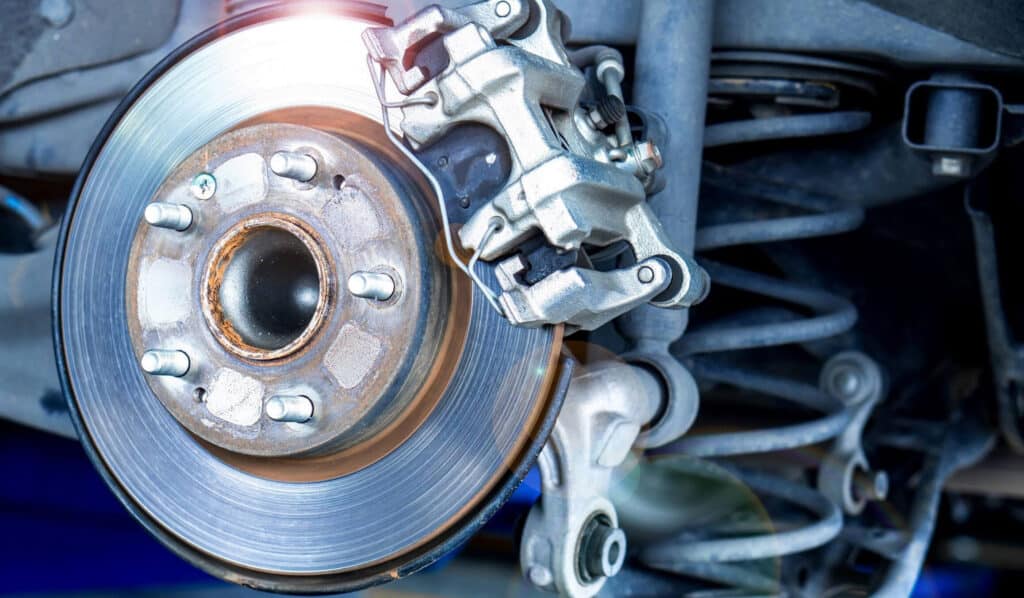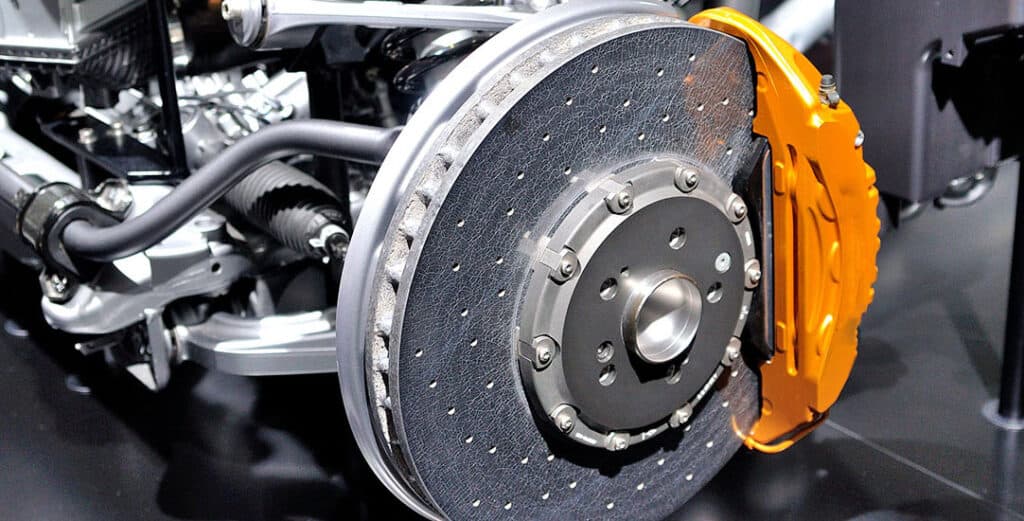The Growing Importance of Electric and Hybrid Fleet Vehicles
As more companies look to incorporate electric and hybrid vehicles into their fleets, it’s essential to understand the unique maintenance needs of these vehicles, particularly when it comes to their brake systems. This article will explore the distinctive aspects of brake systems in electric and hybrid fleet vehicles and discuss tips for maintaining and ensuring their optimal performance.

Understanding Brake Systems in Electric and Hybrid Vehicles
Electric and hybrid vehicles have unique brake systems compared to traditional internal combustion engine vehicles. They often use regenerative braking, which captures the kinetic energy generated during braking and converts it into electricity to recharge the vehicle’s battery. This system reduces wear and tear on the traditional friction brakes, such as brake pads and rotors, but introduces new considerations for maintaining overall brake system health.
Regenerative Braking: How It Affects Brake System Health
Regenerative braking technology helps to extend the life of brake pads and rotors in electric and hybrid vehicles, as the system uses the vehicle’s electric motor to slow down the car, reducing the reliance on friction brakes. However, this does not eliminate the need for regular brake system maintenance. Electric and hybrid vehicles still require periodic inspections and servicing of brake components to ensure optimal performance and safety.
Brake System Maintenance Tips for Electric and Hybrid Fleet Vehicles
1. Regularly inspect brake pads and rotors: Despite the reduced wear from regenerative braking, it’s still important to check brake pads and rotors for signs of wear or damage. Replace components as needed to maintain optimal brake performance.
2. Monitor brake fluid levels: Electric and hybrid vehicles still rely on hydraulic brake systems, so it’s crucial to check brake fluid levels and change the fluid according to the manufacturer’s recommendations.
3. Inspect and maintain regenerative braking components: Regularly inspect the electric motor and other components involved in the regenerative braking system for signs of wear or damage. Consult your vehicle’s manufacturer for specific maintenance guidelines.
4. Perform regular software updates: Keep your electric or hybrid vehicle’s software up to date to ensure the proper functioning of regenerative braking and other systems.
Common Brake System Issues in Electric and Hybrid Vehicles: Prevention and Solutions
1. Reduced friction brake usage: Due to the regenerative braking system, electric and hybrid vehicles may experience less frequent use of their friction brakes. This can lead to corrosion or seizing of brake components. Regular inspections and maintenance can help prevent these issues.
2. Software glitches: Electric and hybrid vehicles rely on complex software systems to manage regenerative braking. Ensure that your vehicle’s software is up to date and address any issues as they arise.
3. Brake system component compatibility: Ensure that any replacement brake components are compatible with your electric or hybrid vehicle’s specific regenerative braking system.
The Connection Between Brake System Health and Electric Vehicle Efficiency
Maintaining the brake system health of electric and hybrid vehicles is critical not only for safety but also for maximizing the efficiency of these vehicles. A well-maintained brake system ensures that regenerative braking functions optimally, helping to recharge the battery and extend the vehicle’s range.

Training and Education for Fleet Drivers and Technicians on Electric and Hybrid Brake Systems
As electric and hybrid vehicles become more prevalent in fleets, it’s essential to provide training and education for drivers and technicians on their unique brake systems. This will ensure that your fleet can identify potential issues and maintain the vehicles effectively. Training should cover:
The fundamentals of regenerative braking and how it differs from traditional friction braking systems: Regenerative braking is a unique feature of electric and hybrid vehicles that sets them apart from traditional internal combustion engine vehicles. In a conventional friction braking system, the kinetic energy generated during deceleration is dissipated as heat through the friction between the brake pads and rotors. In contrast, regenerative braking captures this kinetic energy and converts it into electrical energy, which is then fed back into the vehicle’s battery. This energy recovery process not only extends the range of electric and hybrid vehicles but also reduces wear and tear on the brake components, as the friction brakes are used less frequently.
Specific maintenance requirements and procedures for electric and hybrid vehicles: Maintaining the brake system of electric and hybrid vehicles involves unique procedures and requirements compared to traditional vehicles. One key difference is the reduced need for frequent brake pad and rotor replacements, thanks to regenerative braking. However, electric and hybrid vehicles still require regular inspections of brake components for wear, damage, or corrosion. Additionally, maintenance of the regenerative braking system is crucial, including checking the electric motor, battery, and related software for optimal performance. It’s also essential to follow the manufacturer’s recommendations for brake fluid changes, as this can vary between different electric and hybrid vehicle models.
Recognizing common brake system issues unique to electric and hybrid vehicles and their solutions: Electric and hybrid vehicles can experience specific brake system issues not typically found in traditional vehicles. For example, uneven or premature wear on the friction brake components can occur if the regenerative braking system is not functioning correctly. In such cases, technicians should investigate the cause of the malfunction, which may involve checking the electric motor, battery, or software. Another common issue is brake noise or vibrations due to the reduced frequency of brake pad usage, leading to the formation of rust or glazing on the brake rotors. Regular inspections, cleaning, and replacement of brake components when necessary can help address these unique challenges and ensure the optimal performance of electric and hybrid vehicle brake systems.
Developing a Tailored Brake Maintenance Schedule for Your Electric and Hybrid Fleet Vehicles
To maximize the efficiency and safety of your electric and hybrid fleet vehicles, it’s essential to develop a tailored brake maintenance schedule. This should take into account the unique aspects of electric and hybrid brake systems, as well as your fleet’s specific driving conditions and usage patterns. Factors to consider when developing a maintenance schedule include:
1. The frequency of brake system inspections: Electric and hybrid vehicles may require less frequent friction brake inspections due to regenerative braking. However, it’s essential not to overlook these inspections entirely, as the brake components can still experience wear and damage.
2. Regenerative braking system maintenance: Schedule regular inspections and maintenance for the regenerative braking system components, including the electric motor, battery, and any related software.
3. Brake fluid changes: Follow the manufacturer’s recommendations for brake fluid changes, as this can vary between different electric and hybrid vehicle models.

Conclusion: Adapting to the Unique Brake System Needs of Electric and Hybrid Fleet Vehicles
As electric and hybrid vehicles become more common in fleets, understanding and adapting to their unique brake system needs is essential. By implementing regular maintenance schedules, providing training for drivers and technicians, and addressing common brake system issues, you can maintain the safety and efficiency of your electric and hybrid fleet vehicles. Embracing these unique maintenance requirements will not only contribute to the longevity of your fleet but also ensure that you stay at the forefront of eco-friendly and sustainable fleet management practices.
